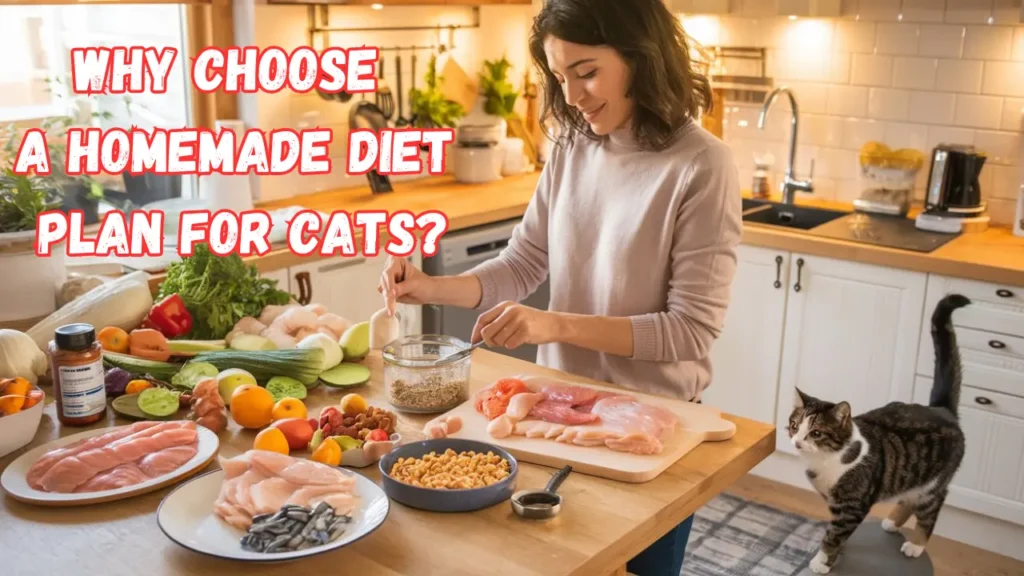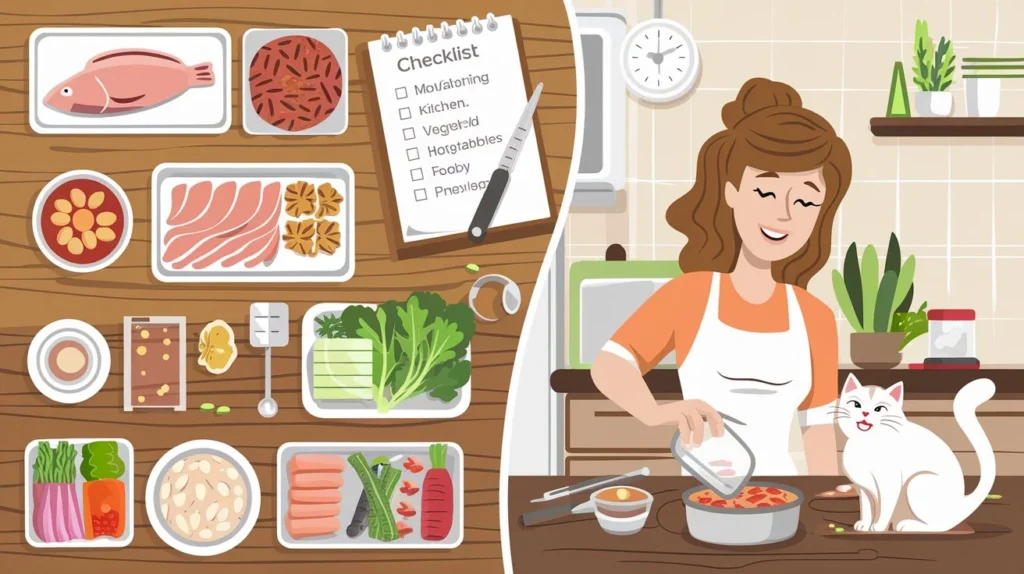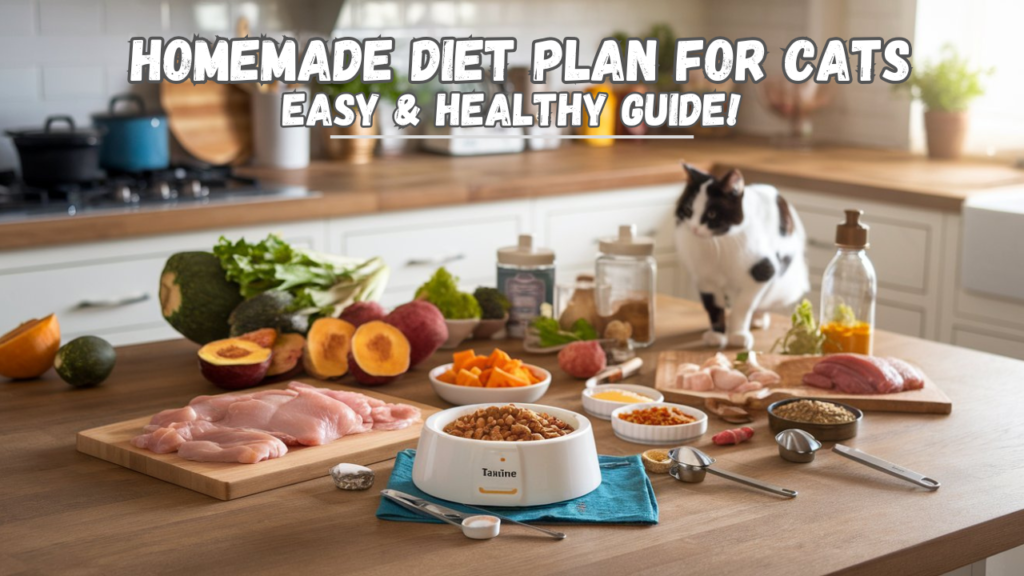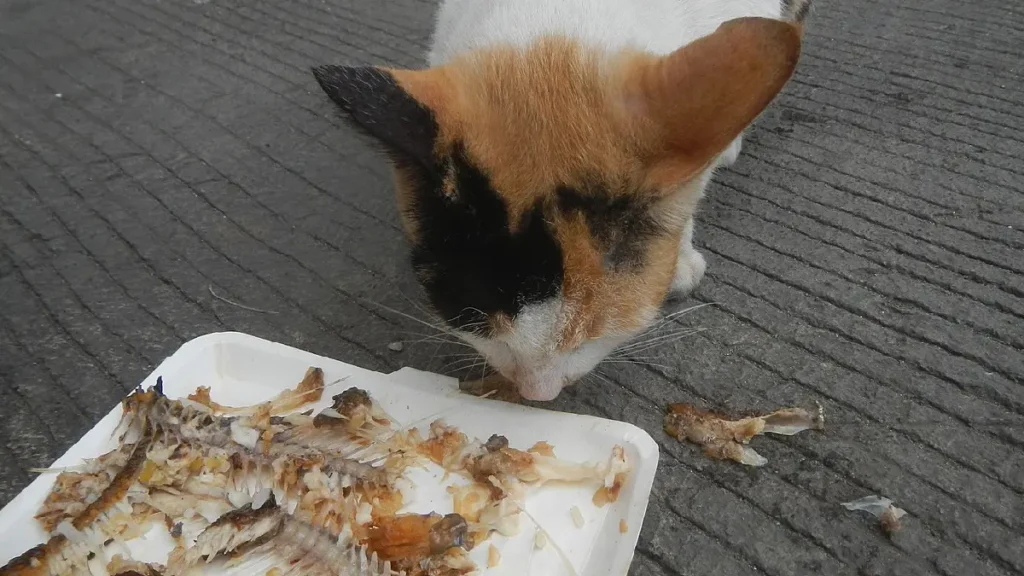Feeding your cat a well-balanced diet is essential for their overall health and longevity. While commercial cat foods offer convenience, many pet owners are turning to homemade diet plans for cats to ensure better control over ingredients and nutritional value. A homemade cat diet can be a healthier and safer option if properly balanced with essential nutrients.
In this guide, we’ll walk you through everything you need to know about creating a healthy homemade diet plan for cats, including the best ingredients, meal preparation tips, and safety guidelines. Let’s dive in!
Table of Contents
Why Choose a Homemade Diet Plan for Cats?

Switching to a homemade cat food diet has several benefits, including:
1. Health Benefits
- Avoids artificial additives and preservatives found in commercial food.
- Reduces the risk of allergies by eliminating common irritants.
- Promotes a shinier coat, better digestion, and improved energy levels.
2. Cost-Effectiveness
- Homemade meals can be cheaper than high-quality commercial cat food.
- Buying ingredients in bulk reduces overall costs.
3. Customization for Your Cat’s Needs
- You can tailor meals based on your cat’s age, weight, and health conditions.
- Ideal for cats with dietary restrictions or medical conditions.
Understanding Your Cat’s Nutritional Needs
Before preparing homemade cat food, it’s crucial to understand your cat’s dietary requirements:
Essential Nutrients for a Balanced Cat Diet
Cats are obligate carnivores, meaning they require animal-based protein to thrive. Here’s what they need:
- Protein: Should make up 50-60% of their diet (chicken, fish, turkey, beef).
- Fats: Provides energy and supports skin/coat health (omega-3, omega-6 fatty acids).
- Taurine: An essential amino acid found in meat, necessary for heart health.
- Vitamins & Minerals: Including calcium, phosphorus, and vitamin A.
- Water: Cats have a low thirst drive, so moisture-rich food is ideal.
Common Mistakes to Avoid in a Homemade Cat Diet
- Lack of Taurine: Can lead to heart disease and blindness.
- Feeding Too Many Carbs: Cats don’t need grains or excessive carbohydrates.
- Raw Food Handling Issues: Bacteria in raw meat can cause foodborne illnesses.
- Skipping Vet Consultation: Every cat has unique dietary needs.
Step-by-Step Guide to Creating a Homemade Diet Plan for Cats

1. Choosing the Right Ingredients
- Best Protein Sources: Chicken, turkey, fish, beef, lamb.
- Healthy Fats: Fish oil, chicken fat, and beef fat.
- Safe Vegetables (in moderation): Carrots, pumpkin, peas.
- Optional Grains (for some cats): Brown rice, oatmeal (if tolerated).
2. Sample Homemade Cat Food Recipes
Recipe 1: Simple Chicken & Rice Meal
Ingredients:
- 1 cup cooked chicken (shredded)
- 1/4 cup cooked brown rice
- 1/4 cup mashed pumpkin
- 1 teaspoon fish oil
- Taurine supplement (per vet’s recommendation)
Instructions:
- Cook chicken thoroughly and shred it into small pieces.
- Mix in cooked brown rice and mashed pumpkin.
- Add fish oil and taurine supplement.
- Serve fresh or store in an airtight container in the refrigerator for up to 3 days.
Recipe 2: Fish & Pumpkin Delight
Ingredients:
- 1 cup cooked salmon (deboned)
- 1/2 cup steamed carrots (mashed)
- 1 teaspoon olive oil
- Taurine supplement
Instructions:
- Cook the salmon thoroughly, removing all bones.
- Mash steamed carrots and mix them with the salmon.
- Add olive oil and taurine supplement.
- Serve fresh or store in an airtight container.
3. Portion Control and Meal Frequency
- Kittens (up to 6 months): 4 small meals per day
- Adult cats: 2-3 meals per day
- Senior cats: 2 small meals per day
Use a vet-approved cat calorie calculator to determine daily portions based on weight and activity level.
Safety Tips & Storing Homemade Cat Food
- Store food in airtight containers to maintain freshness.
- Refrigerate meals and use within 3 days.
- Freeze bulk meals and thaw before serving.
- Avoid using raw ingredients if your cat has a sensitive stomach.
Consulting a Veterinarian for a Balanced Diet
Even though homemade cat food can be beneficial, consulting a vet is highly recommended:
- Vets can approve homemade recipes to ensure they meet nutritional needs.
- Regular check-ups help monitor weight, digestion, and overall health.
- They can recommend supplements to fill any nutritional gaps.
Homemade Diet Plan for Cats: A Comprehensive Q&A Guide
When it comes to feeding your cat, a homemade diet plan can offer many benefits, including better control over ingredients and nutrition. However, making the right choices for your cat’s health and well-being can be overwhelming. This Q&A guide will answer the most common questions about creating a homemade diet plan for your feline friend.
1. Why should I consider a homemade diet plan for my cat?
Answer:
A homemade diet plan for cats can provide many advantages, such as better control over the quality of food and ingredients. Some cats have specific dietary needs, food sensitivities, or allergies that can be addressed more effectively with home-prepared meals. Additionally, homemade meals can ensure that your cat is receiving a balanced and nutritious diet tailored to their age, size, and health status. However, it’s important to consult with a vet to ensure you’re meeting all of your cat’s nutritional needs.
2. What ingredients should be included in a homemade diet for cats?
Answer:
A well-balanced homemade diet for cats should include high-quality protein, essential fats, vitamins, and minerals. Here are key ingredients to include:
- Protein: Chicken, turkey, beef, or fish are great sources of animal-based protein, which is essential for a cat’s muscle development and overall health.
- Healthy Fats: Animal fats like chicken fat, fish oil, or flaxseed oil provide necessary omega-3 and omega-6 fatty acids, which are crucial for a cat’s coat and skin health.
- Fiber: Cats need a small amount of fiber for digestive health. Consider adding small amounts of cooked vegetables like pumpkin or sweet potatoes.
- Calcium and Phosphorus: Cats need balanced levels of calcium and phosphorus for bone health. You can add crushed eggshells or bone meal to their diet for these minerals.
- Taurine: This essential amino acid is vital for heart and eye health. If your homemade diet plan doesn’t include organ meats (like liver), taurine supplements may be necessary.
3. Can I feed my cat only meat, or do I need to include other ingredients in their diet?
Answer:
While meat is an essential component of a homemade diet for cats, it’s important to include a variety of other ingredients to ensure they get a balanced diet. Cats are obligate carnivores, meaning they require meat for protein, but they also need vitamins, minerals, and amino acids (such as taurine) that may not be present in meat alone. Including small amounts of vegetables, fruits, and specially designed supplements will ensure your cat receives all the necessary nutrients for optimal health.
4. How do I ensure that my homemade cat diet is nutritionally balanced?
Answer:
To ensure your homemade cat diet is nutritionally balanced, follow these key guidelines:
- Consult with a Veterinarian or Pet Nutritionist: It’s essential to seek professional advice to create a diet plan that meets your cat’s specific needs. A vet or nutritionist can help you formulate a plan that includes all the necessary nutrients in the right proportions.
- Use Commercial Supplements: In many cases, homemade cat diets require specific vitamin and mineral supplements to ensure balance, especially taurine, vitamin A, and arachidonic acid.
- Avoid Harmful Foods: Avoid giving your cat foods that are toxic to them, such as onions, garlic, chocolate, and grapes. These can be dangerous and cause serious health issues.
5. What are some common mistakes to avoid when preparing a homemade diet for cats?
Answer:
When preparing a homemade diet for cats, it’s easy to make mistakes. Here are some common ones to avoid:
- Imbalanced Diets: Focusing too much on meat and neglecting other necessary nutrients like calcium, taurine, and fatty acids can lead to nutritional deficiencies.
- Feeding Only One Protein Source: While variety is essential, feeding only one type of protein, like chicken, may lead to an unbalanced intake of amino acids and other nutrients. Rotate protein sources to ensure balanced nutrition.
- Excessive Amounts of Carbohydrates: Cats have a low carbohydrate requirement, so avoid including too many starchy vegetables or grains in their meals. These can cause weight gain or digestive issues.
- Lack of Proper Preparation: Ensure that meat is cooked properly and bones are removed to prevent choking hazards or digestive issues.
6. Can I use a slow cooker or pressure cooker to prepare homemade meals for my cat?
Answer:
Yes, a slow cooker or pressure cooker can be a great tool for preparing homemade meals for your cat. These methods help retain the moisture in meats and vegetables, making them easier to digest. However, avoid using seasonings or salt, as these can be harmful to cats. Always ensure that you’re using pet-safe ingredients and avoid any toxic foods, such as onions or garlic, when preparing meals.
7. How much homemade food should I feed my cat daily?
Answer:
The amount of homemade food you should feed your cat depends on their age, weight, activity level, and overall health. On average, an adult cat requires about 20 calories per pound of body weight per day. For example, if your cat weighs 10 pounds, they would need approximately 200 calories a day. You can adjust this based on your cat’s condition, but it’s best to consult with a veterinarian to determine the right portion size and feeding schedule for your cat.
8. Can I switch my cat to a homemade diet gradually?
Answer:
Yes, it’s important to switch your cat to a homemade diet gradually to avoid digestive upset. Start by mixing small amounts of homemade food with their regular food and gradually increase the proportion of homemade meals over a period of 7 to 10 days. This will help your cat’s digestive system adjust to the new diet. Monitor your cat for any signs of gastrointestinal issues like diarrhea or vomiting during the transition.
9. Are there any specific diets recommended for cats with medical conditions?
Answer:
Yes, homemade diets can be tailored to meet the needs of cats with medical conditions, but it’s crucial to consult with a veterinarian before making any changes. Cats with conditions like kidney disease, diabetes, or obesity may require special dietary considerations, such as lower protein, reduced phosphorus, or controlled carbohydrate content. A veterinarian can guide you in adjusting the ingredients and nutrients to meet your cat’s specific health needs.
10. Is it okay to prepare meals for my cat in advance and store them?
Answer:
Yes, you can prepare homemade meals for your cat in advance and store them in the refrigerator or freezer. Make sure the food is properly stored in airtight containers to maintain freshness. Frozen meals can be thawed as needed, but be sure to follow safe food-handling guidelines. Always check the food before feeding to ensure it has not spoiled, and avoid reheating the food too many times.
Conclusion:
A homemade diet plan for cats can be an excellent way to ensure they get high-quality, nutritious meals tailored to their specific needs. However, it’s essential to strike the right balance of ingredients and nutrients to avoid deficiencies or health problems. By consulting with a professional and avoiding common mistakes, you can provide your cat with a healthy, homemade diet that supports their long-term well-being.


